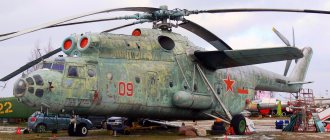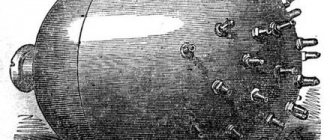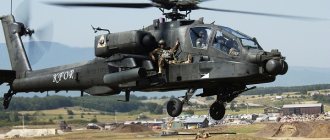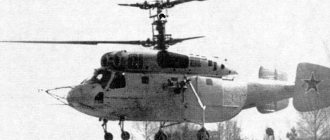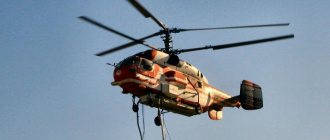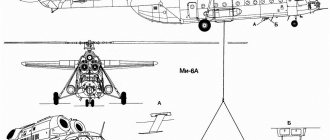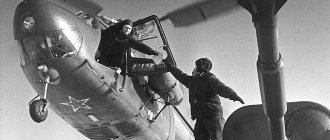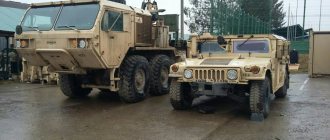In the mid-60s, Soviet sailors were faced with the urgent question of a specialized anti-submarine helicopter, which would be based on a proven and well-known machine. At this time, the designers of the Kamov Design Bureau were working on the creation of the anti-submarine Ka-25, but its characteristics did not allow placing on board the entire range of equipment necessary to combat submarines, and splashdown capabilities were not provided for this vehicle.
Back in the late 50s, OKB-329 began work on the creation of a PLO helicopter. At this time, the designers of the Milevsky design bureau were engaged in the creation of the famous “eight”, one of its modifications was supposed to become an anti-submarine amphibious helicopter. However, this rotary-wing aircraft took its first flight only in August 1967, and operation began in May 1976. The helicopter received the designation Mi-14.
The Mi-14 is a coastal-based multi-purpose amphibious helicopter whose main function is to combat enemy submarines. However, it can also be used to perform absolutely peaceful tasks: to carry out search and rescue operations, transport goods and passengers, and extinguish forest fires. The Mi-14 helicopter is a coastal-based aircraft.
In 1973, serial production of the Mi-14 amphibious helicopter was launched at the Kazan Helicopter Plant. It lasted until 1986. During this period, the company managed to produce 273 rotorcraft of this type; a number of modifications of the helicopter were created based on the basic model.
Despite the fact that the Mi-14 helicopter has been officially removed from service with the Russian army for a long time, its operation continues to this day. In addition to Russia, these machines are used in Georgia, Ukraine, Cuba, Poland and the Baltic countries. Pilots love the Mi-14 for its reliability, unpretentiousness, and ease of operation. And for the high level of comfort for the crew, pilots generally call the Mi-14 a “liner.”
Several years ago, Russian Defense Minister Sergei Shoigu officially announced plans to resume serial production of the Mi-14 in Kazan. If they are brought to life, then the updated “fourteenth” will undoubtedly find its application not only in army service, but also in civilian life.
However, before talking about the future of this wonderful machine, I would like to say a few words about the stages of its creation and give a technical description of the Mi-14 helicopter.
Stages of creating a helicopter
The idea of using helicopters to detect and destroy enemy submarines arose almost immediately after the appearance of these machines. The first attempts were made during the Second World War. The Americans can be called pioneers in this area, although the Germans also tried to adapt the FI 282 gyroplane for anti-submarine defense.
And this should not be surprising. The helicopter was ideal for this type of work. He could reach the area where the submarine was supposed to be much faster than any ship, and in a short period of time conduct a survey of a large area. Unlike airplanes, rotorcraft do not need expensive airfields; they can be placed directly at coastal bases, or even on board a ship. In addition, the use of helicopters for anti-aircraft defense is much cheaper than surface ships or submarines.
During the Cold War, the importance of the submarine fleet increased many times over. The submarines received a nuclear power plant and turned into floating ballistic missile launchers with a nuclear warhead. Therefore, the fight against them became a priority task, the solution of which received a huge amount of attention in both the USA and the USSR.
Already in the early 50s, the famous American company Sikorsky manufactured the first anti-submarine helicopter, the H04S-1, and a few years later, serial production of the Sikorsky H-34 began, on board which was placed fairly advanced equipment for searching for Soviet submarines. At the same time, the British also became concerned with the creation of anti-submarine helicopters. In the 60s, the US Navy received the legendary SH-3A Sea King helicopter.
The Soviet Union closely monitored these processes. It should be noted that during this period the USSR lagged behind in the field of marine helicopter construction. Traditionally, the creation of such machines was carried out by the Kamov design bureau, but it should be recognized that in the 50-60s, Soviet helicopters for the Navy were significantly inferior to their Western counterparts.
The naval sailors wanted to get a car that would not be inferior in its characteristics to the American Sea King, and was built on the basis of an existing, proven and well-known car. The ideal candidate for such a role was the Milevsky Mi-8 helicopter.
As mentioned above, the idea of creating an anti-submarine helicopter based on the transport and landing Mi-8 arose during the creation of this helicopter. The amphibious modification of the G8 was called V-8G. At that time, the USSR carried out two programs related to new generation air defense systems - “Juniper” and “Elm”. Their result was the creation of a set of tactical and technical requirements, which was transferred to the designers of the Mil Design Bureau in the early 60s. The military needed an amphibious helicopter capable of searching for enemy submarines in any weather conditions, at night or during the day, at a distance of 200 km from the coast, conducting surveillance for at least 2 hours, and, if necessary, hitting the enemy at a depth of up to 400 meters and at a speed of 30 nodes
Work on the car progressed slowly. Firstly, the developers did not have an engine that would provide the helicopter with the necessary power supply - it had yet to be created, and secondly, the customer changed the requirements for the machine several times, which seriously delayed the process. Only in 1964 were they finally formulated. In 1965, a government decree was issued on the creation of search and attack helicopters. In 1966, the Milevians proposed creating a search and strike complex based on one vehicle. This option was accepted. At the development stage, the helicopter was named B-14.
And although it would seem that the new car is not being created from scratch, but on the basis of the serial Mi-8, nevertheless, the designers had a lot of work. First of all, it was necessary to significantly alter the helicopter's glider: it had a boat-bottom, as well as side floats, which provided the machine with the ability to stay afloat even with sea waves of 3-4 points. The B-14 became the first Soviet helicopter with retractable landing gear; additional fuel tanks appeared, which were supposed to provide the required patrol range. Now the engine was started not from the batteries, but from the auxiliary power unit. The developers had to create a new gearbox, the tail rotor was moved to the other side, and the onboard equipment complex also underwent very serious changes.
In the summer of 1967, factory testing of the vehicle began, and on August 1 the helicopter took off for the first time. Initially they were held in the Moscow region, then they were moved to Crimea. In 1968, the stage of state testing began, which continued until 1973. The design of the helicopter was regularly modified, eliminating defects and shortcomings. During the tests, only one serious incident occurred: during an emergency landing, one of the prototypes overturned. There were no casualties, but the helicopter was so damaged that it could no longer be restored.
The acceptance certificate for the helicopter was signed only in 1974, so the development of the future Mi-14 lasted more than seven years. It should be noted that the successful developments obtained during the creation and production of the Mi-14 were then used in the design of other Milevsky helicopters: the Mi-24 and Mi-8MT.
Officially, the Mi-14PL anti-submarine helicopter was put into service only in May 1976. Only Kazan plant No. 387 was involved in the production of the car.
Mi-12 - the most load-lifting
The heaviest and most load-lifting helicopter in the history of world aviation. The first flight took place on July 10, 1968. On August 6, 1969, he lifted a load of 44,205 kg to a height of 2255 m, setting a world record for helicopter lifting capacity, which has not yet been broken. In total, the Mi-12 set seven world records.
Mi-12
For the creation of a super-heavy helicopter, the Mil Design Bureau was awarded the I.I. Sikorsky, awarded by the American Helicopter Society for outstanding achievements in helicopter technology.
The main distinguishing feature of the Mi-12 is the lateral arrangement of the propellers on the wings of reverse narrowing. The vehicle was created as a super-heavy transport helicopter with a payload capacity of at least 30 tons to transport intercontinental ballistic missiles for units of the Strategic Missile Forces. The 105-ton “heavyweight” was lifted into the air by four 6,500 hp engines. every. The Mi-12 could reach speeds of up to 260 km/h. Crew - six people.
The front part of the fuselage was occupied by a two-story cabin. In the tail section there was a power ladder with side doors, which, when opened, formed an opening for the entry of equipment and loading of cargo. The central part of the helicopter was occupied by a gigantic cargo compartment. However, the military did not need such a giant, and both helicopters were turned into museum exhibits. However, the experience of designing and testing these exceptional machines was not wasted later.
Current situation
After the collapse of the Soviet Union, most Mi-14s went to the Russian Federation. In 1992, a decision was made to remove this helicopter from service. It is not difficult to explain: at that time there was a general reduction in the armed forces, it was expensive to maintain a large range of aircraft, so they were mercilessly slaughtered. The Mi-14 was planned to be completely replaced by the more modern Ka-27, which, moreover, could be based not only on the shore, but also on the ship’s deck.
Although the Mi-14 is currently considered decommissioned, it is nevertheless used to a limited extent in civil aviation and by the Russian Ministry of Emergency Situations. Another four helicopters are in service with the Ukrainian Armed Forces, and one or two helicopters are operated in Georgia. The Poles have modernized the Mi-14 and still use them for anti-submarine defense.
In service
The Mi-14 was put into service in 1976 and entered service with the following units of aviation of the USSR Navy: 555th separate anti-submarine helicopter regiment (OPLVP), 745th SPLVP, 872nd SPLVP (Kacha village near Sevastopol), 51- yu OPLV squadron and 710th OPLV squadron (Kuril Islands), 830th OPLV squadron (Severomorsk) and 169th mixed aviation regiment (Cam Ranh) [1]. Until 1991, about 150 Mi-14s were exported to Bulgaria, Vietnam, Poland, Cuba, North Korea, Libya, Syria, East Germany, Yugoslavia and Yemen. A number of Mi-14s were subsequently re-exported to Ethiopia.
In service
- Georgia Georgia - 2 Mi-14, as of 2020[5];
- Yemen Yemen - 2 Mi-14, as of 2013;
- Comoros Comoros - 2 Mi-14, as of 2013. Delivered from Ukraine. Participated in the operation on Ndzuani Island in 2008.
- Cuba Cuba - 5 Mi-14s in storage, as of 2016[6].
- Libya Libya - more than 1 Mi-14, as of 2020, is used as transport helicopters[7]. In 1981, a batch of 16 Mi-14E helicopters was purchased. Later, another batch of 16 Mi-14Es was purchased;
- Poland Poland - 10 Mi-14, as of 2020[5]. The Polish Navy aviation received 12 Mi-14E and 5 Mi-14PS in 1982-85. They became part of the Darlova-based 29th Squadron (corresponding to a squadron), then part of the 16th Helicopter Regiment, which is currently reorganized into the 2nd Air Division;
- Russia Russia - 20 Mi-14 and 40 Mi-14PS, as of 2016[8]
- Syria Syria - 6 Mi-14, as of 2020[9].
- Ukraine Ukraine - 3 Mi-14 PS/PL, as of 2016[10].
Was in service
- USSR USSR - was in service until the collapse of the country in 1991;
- Russia Russia - The Mi-14PL was withdrawn from service with the Russian Navy in 1996, and the Mi-14PS in 2004[1][11];
- Bulgaria Bulgaria - in 1979–1980, Bulgaria received 6 Mi-14PL from the USSR, one of which crashed in January 1986. In 1990, 3 more used Mi-14PLs were purchased. In 1983, 2 Mi-14BT minesweeper helicopters entered service with a separate helicopter squadron, one of them was decommissioned in 1985, the minesweeper equipment was removed from the second, after which the helicopter was used as a transport helicopter. By 2001, four Mi-14PLs remained airworthy, two of which were repaired in 2000, with the aim of extending their service life until 2007-2008. Currently, the Mi-14PL is expected to be replaced by the recently acquired AS.565MB Panther, which will be delivered in 2010-2011[12][13]. Completely withdrawn from service in 2013;
- Vietnam Vietnam
- GDR GDR - Volksmarine (GDR Navy) in 1979 received 9 Mi-14E and 6 Mi-14BT. They entered service with the MHG-18 Kurt Barthel naval helicopter squadron, based at the Parov airfield. Since many mines remained in the Baltic waters since the Second World War, the German Mi-14BT regularly had to mine them. After the reunification of Germany, the Armed Forces of the former GDR ceased to exist. A new group was created on the basis of MHG-18, which became part of the Bundesmarine. For a short time, all six Mi-14BT continued to be used as transport and search and rescue aircraft, and one Mi-14E as a trainer. The remaining helicopters were mothballed. On December 20, 1991, the operation of the Mi-14 in the Bundesmarine ceased. The Germans sold two helicopters to the USA, where they underwent thorough testing. She acquired 9 more cars in 1993, and the remaining 3 were transferred to museums;
- DPRK DPRK
- Cuba Cuba
- Yugoslavia Yugoslavia - 4 Mi-14. Destroyed in 1999 during a NATO air attack.
- Ethiopia Ethiopia
Description of the Mi-14 design
The helicopter is manufactured according to the classical design with one main rotor and one tail rotor. It has a four-wheel retractable landing gear, and the vehicle's power plant consists of two gas turbine engines. The Mi-14 crew consists of two pilots and two equipment operators.
The Mi-14 was created on the basis of the Mi-8 airborne transport, so the upper part of the body of these two helicopters is almost similar. But the lower part of the amphibious helicopter has significant differences: the bottom is made in the form of a boat with well-defined cheekbones, fairings, and to increase buoyancy there are two inflatable ballonets with a volume of four cubic meters.
The helicopter has a five-bladed rotor with hinged blades. Three-bladed tail rotor with variable pitch.
The front part of the hull is occupied by the cockpit, behind which is the cargo compartment, which occupies the main part of the hull. Unlike the Mi-8, the Mi-14 helicopter does not have a rear cargo hatch, but it does have a small hatch for a magnetometer. The radar station is located in the nose of the helicopter. In the anti-submarine version of the helicopter, the cargo compartment contains search equipment, winches for lowering the magnetometer and sonar station, as well as torpedoes and depth charges. In the search and rescue modification of the helicopter, the cargo compartment is equipped with places for victims.
The Mi-14 power plant includes two TVZ-117M gas turbine engines, as well as cooling systems, fire protection, engine starting, fuel supply, etc. The take-off power of each engine is 2 thousand hp. With.
The helicopter's fuel system consists of six tanks, their total capacity is 3350 liters. If necessary, another additional tank of 500 liters can be installed in the cargo compartment.
The Mi-14 has a four-leg retractable landing gear, consisting of two front and two main struts. In addition, a non-retractable support is located on the tail boom. The front struts retract forward into the fuselage niches, and the main struts retract back into the fairings.
If we talk about the anti-submarine modification of the Mi-14, then to perform its functions it is equipped with: the Initiative-2 radar station, the APM-60 magnetometer, the Oka-2 hydroacoustic station, the R-842M radio stations (HF range) and R- 860 (VHF band), radio altimeter RV-Z, radio compasses ARK-9 and ARK-U2, Doppler meter DISS-15 and autopilot AP-34B.
In addition, the complex of anti-submarine equipment also includes the “Lily of the Valley” sighting and computing device, the “Snegir” data transmission system, and “Float” buoys. The automatic control system of the SAU-14 allows the helicopter to hover over one point.
The Mi-14PL can carry twelve 50 kg bombs or eight 250 kg bombs, the total bomb load is 2 thousand kg, as well as one AT-1 torpedo. Instead of torpedo-bomb weapons, acoustic buoys (36 RSL-NM Chinara) can be loaded on board. Weapons can be placed both inside the cargo compartment and on external slings. The anti-submarine Mi-14 is capable of carrying the Scalp depth charge with a nuclear warhead. Its mass is 1600 kg, and its power is 1 Kt.
As a rule, Mi-14 anti-submarine helicopters operate in pairs: one vehicle carries a set of equipment for searching for submarines, and the second carries a torpedo and depth charges.
Mi-26 – “flying cow”
The world's highest lifting production helicopter. Due to its size, it received the unofficial name “flying cow”.
Mi-26
The Mi-26 is designed to perform transport, evacuation, fire fighting and other missions. The first flight took place on December 14, 1977. Serially produced from 1980 to the present, more than 300 copies have been produced. It is built according to a single-rotor design with an eight-blade main and five-blade tail rotors, equipped with two gas turbine engines and a fixed tricycle landing gear. Depending on the modification, the crew can consist of five to six people. Maximum speed is 270 km/h, maximum flight range with main tanks is 800 km, service ceiling is 4600 meters. Capable of carrying up to 85 paratroopers or 60 wounded on stretchers, or up to 20 tons of cargo inside the fuselage or on an external sling.
About 15 modifications have been developed based on the Mi-26. In 2020, the Russian Helicopters holding company began serial production of a modernized version - the Mi-26T2. It is equipped with new avionics, which makes it possible to reduce the crew from five to two or three people and use the helicopter at night. In addition, it does not require special airfield maintenance facilities and is adapted for long-term autonomous deployment.
Modifications of the Mi-14 helicopter
Since the start of mass production, several modifications of the Mi-14 helicopter have been created:
- Mi-14GP. Utility-passenger modification of the helicopter;
- Mi-14BT. A version of the vehicle that is intended for trawling sea mines. The helicopter is capable of towing various types of contact and non-contact trawls. Moreover, towing can be carried out by one helicopter or two vehicles;
- Mi-14P. A civil modification designed to transport passengers. It can carry up to 24 people. Actively used by oil workers. Actually, according to their order, it was developed in 1995;
- Mi-14PZh "Eliminator". A version of the helicopter designed for firefighting. The basis for its creation was a modification of the Mi-14BT. This machine is the joint brainchild of Russian designers and German specialists. Its special feature is the installation of a water tank in the cargo compartment, which is drained through opening doors. To date, only one machine of this modification has been built. She took part in extinguishing large-scale forest fires in Spain;
- Mi-14PL. PLO helicopter, which is the most popular modification of the machine;
- Mi-14PLM. This helicopter is an attempt to modernize the anti-submarine version. It was planned to install a new anti-submarine complex “Octopus” on it and arm it with “Kolibri” and “Orlan” torpedoes. However, the modification remained on paper, the project was closed;
- Mi-14PW. Modification of the Mi-14PL helicopter, created in Poland.
Mi-24 – “flying infantry fighting vehicle”
The most combative helicopter in the world, it took part in more than 30 local conflicts: in hostilities in the Pamir Mountains, in the gorges of the Caucasus, in the tropical forests of Equatorial Africa and in the sultry Asian deserts. The first Soviet combat helicopter. Military glory came to him in Afghanistan, where he received the nickname “Crocodile”.
Mi-24
The Mi-24 is the only attack helicopter capable of performing landing functions - a “flying infantry fighting vehicle.” Designed for fire support of troops on the battlefield, tactical landings, and can perform transport functions. The first flight took place on September 19, 1969. It was serially produced from 1970 to 1989, with a total of about 3,500 copies produced.
In 1978, it set an absolute world speed record for helicopters - 368.4 km/h.
Currently, the Mi-24 is in service with about 45 countries. In total, in 1991–2014, foreign customers received 171 combat vehicles.
The Mi-24 has become a symbol of the transport and combat helicopter. Since 1991, the most popular models have been the Mi-24P with cannon armament. The Mi-24V, equipped with a quad 12.7 mm machine gun, was also supplied. Today, an improved modification, the Mi-35, is entering service with the troops.

